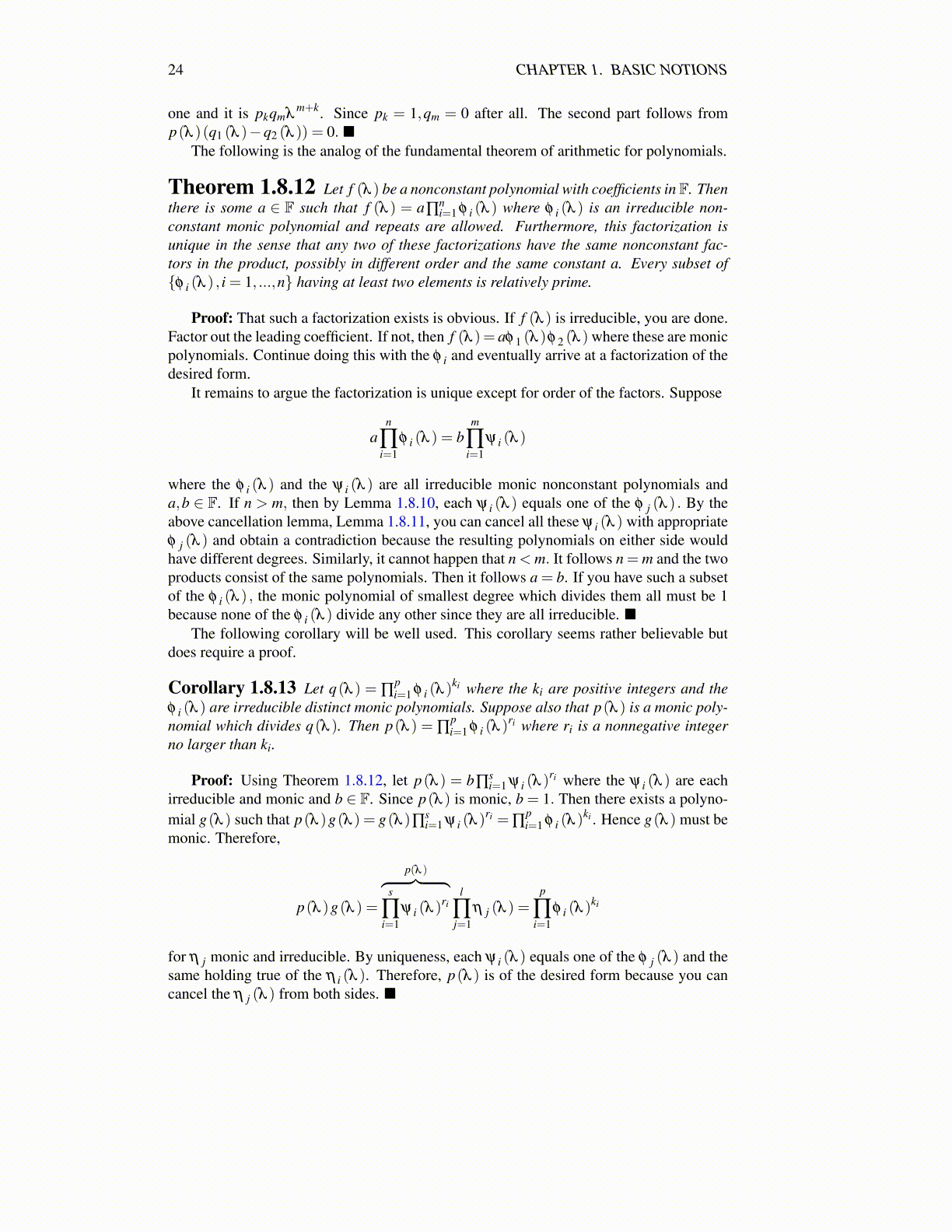
24 CHAPTER 1. BASIC NOTIONS
one and it is pkqmλm+k. Since pk = 1,qm = 0 after all. The second part follows from
p(λ )(q1 (λ )−q2 (λ )) = 0. ■The following is the analog of the fundamental theorem of arithmetic for polynomials.
Theorem 1.8.12 Let f (λ ) be a nonconstant polynomial with coefficients in F. Thenthere is some a ∈ F such that f (λ ) = a∏
ni=1 φ i (λ ) where φ i (λ ) is an irreducible non-
constant monic polynomial and repeats are allowed. Furthermore, this factorization isunique in the sense that any two of these factorizations have the same nonconstant fac-tors in the product, possibly in different order and the same constant a. Every subset of{φ i (λ ) , i = 1, ...,n} having at least two elements is relatively prime.
Proof: That such a factorization exists is obvious. If f (λ ) is irreducible, you are done.Factor out the leading coefficient. If not, then f (λ )= aφ 1 (λ )φ 2 (λ ) where these are monicpolynomials. Continue doing this with the φ i and eventually arrive at a factorization of thedesired form.
It remains to argue the factorization is unique except for order of the factors. Suppose
an
∏i=1
φ i (λ ) = bm
∏i=1
ψ i (λ )
where the φ i (λ ) and the ψ i (λ ) are all irreducible monic nonconstant polynomials anda,b ∈ F. If n > m, then by Lemma 1.8.10, each ψ i (λ ) equals one of the φ j (λ ) . By theabove cancellation lemma, Lemma 1.8.11, you can cancel all these ψ i (λ ) with appropriateφ j (λ ) and obtain a contradiction because the resulting polynomials on either side wouldhave different degrees. Similarly, it cannot happen that n < m. It follows n = m and the twoproducts consist of the same polynomials. Then it follows a = b. If you have such a subsetof the φ i (λ ) , the monic polynomial of smallest degree which divides them all must be 1because none of the φ i (λ ) divide any other since they are all irreducible. ■
The following corollary will be well used. This corollary seems rather believable butdoes require a proof.
Corollary 1.8.13 Let q(λ ) = ∏pi=1 φ i (λ )
ki where the ki are positive integers and theφ i (λ ) are irreducible distinct monic polynomials. Suppose also that p(λ ) is a monic poly-nomial which divides q(λ ). Then p(λ ) = ∏
pi=1 φ i (λ )
ri where ri is a nonnegative integerno larger than ki.
Proof: Using Theorem 1.8.12, let p(λ ) = b∏si=1 ψ i (λ )
ri where the ψ i (λ ) are eachirreducible and monic and b ∈ F. Since p(λ ) is monic, b = 1. Then there exists a polyno-mial g(λ ) such that p(λ )g(λ ) = g(λ )∏
si=1 ψ i (λ )
ri = ∏pi=1 φ i (λ )
ki . Hence g(λ ) must bemonic. Therefore,
p(λ )g(λ ) =
p(λ )︷ ︸︸ ︷s
∏i=1
ψ i (λ )ri
l
∏j=1
η j (λ ) =p
∏i=1
φ i (λ )ki
for η j monic and irreducible. By uniqueness, each ψ i (λ ) equals one of the φ j (λ ) and thesame holding true of the η i (λ ). Therefore, p(λ ) is of the desired form because you cancancel the η j (λ ) from both sides. ■